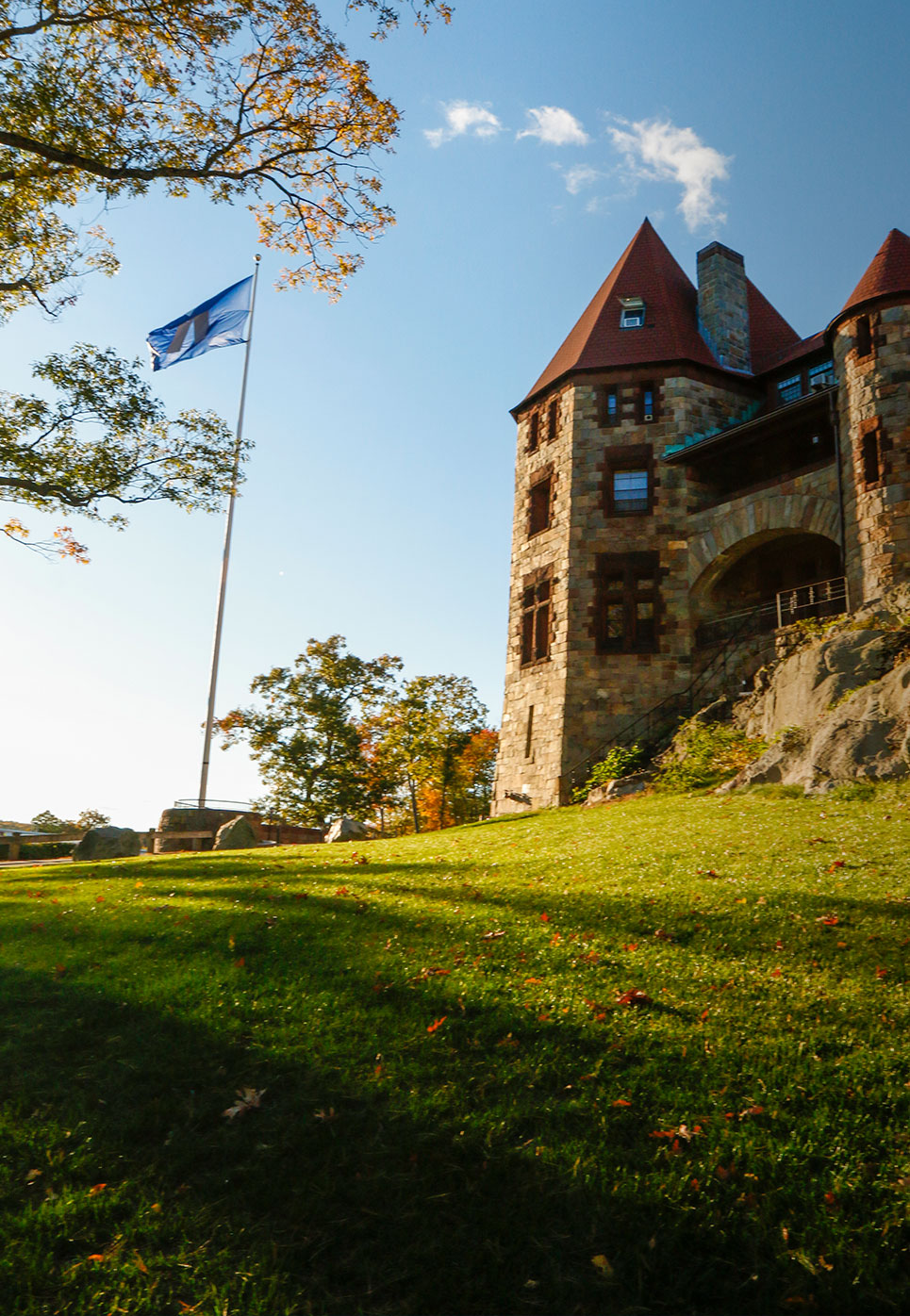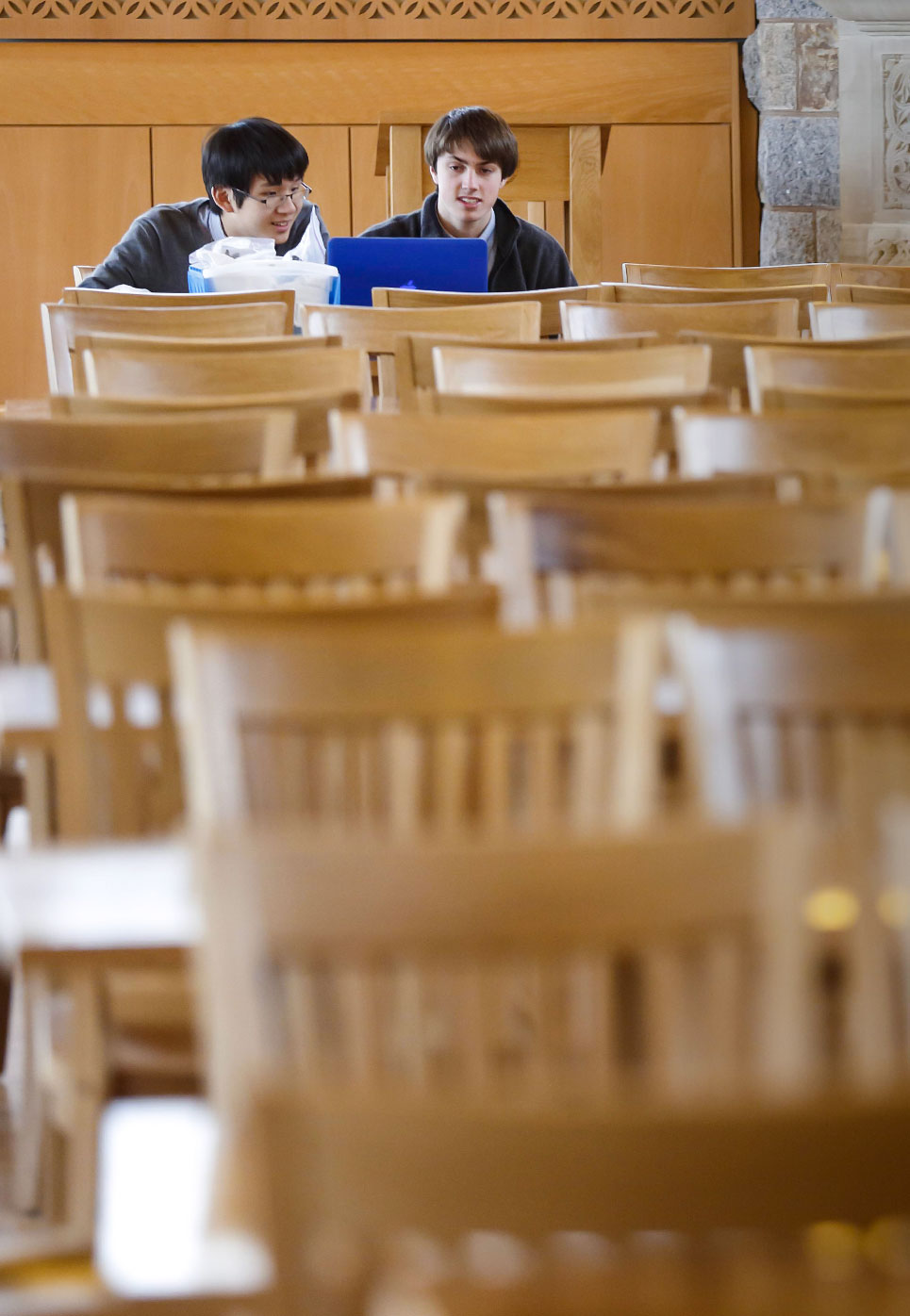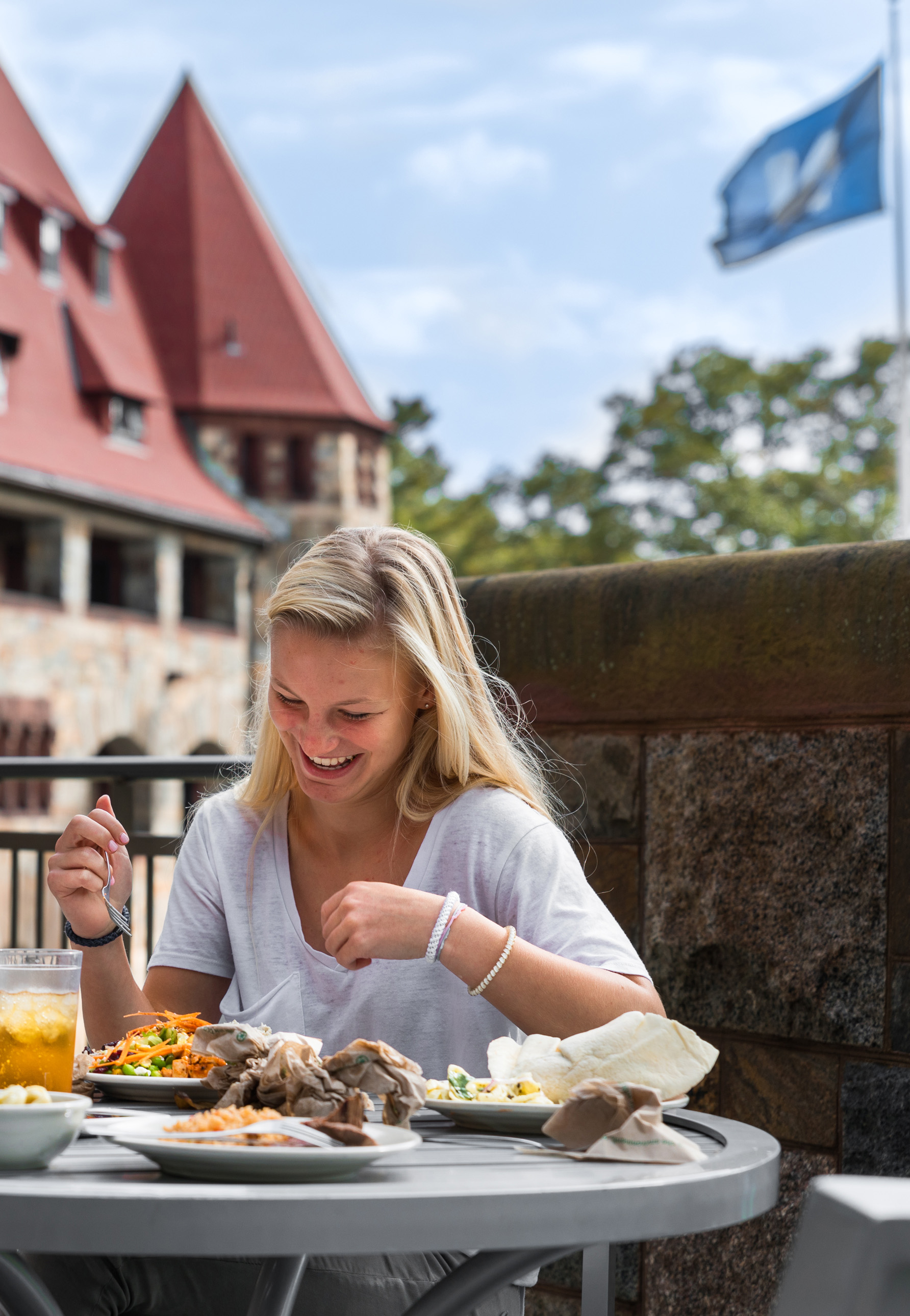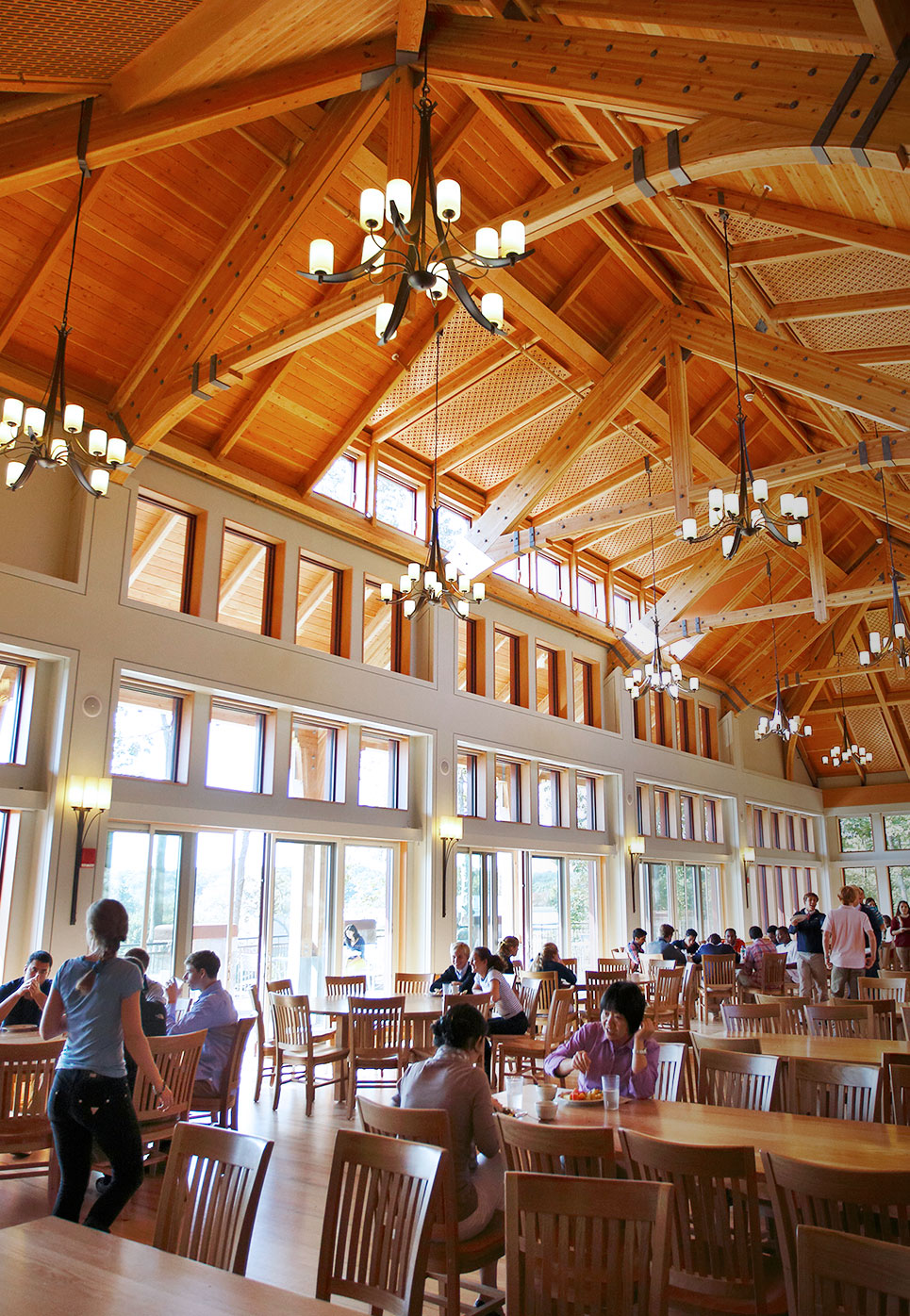2020-2021 Campus Spaces
As we return to our campus, protecting the health of our community and preventing the spread of Covid-19 remains our top priority. From following state and public health guidelines around social distancing to new cleaning and disinfecting protocols, we are working creatively to maximize space and create areas for learning that are informed by recommendations for evolving best practices. We rely on students, employees and their families to follow health and safety guidelines.
Social Distancing
All campus classrooms and gathering spaces will be set up to ensure there are at least 6 feet of distance between students and teachers. We will do everything we reasonably can to create classrooms, offices, and common areas with appropriate spacing. In some cases, we have installed additional materials such as plexiglass. The number of students in each space will be based on the physical size and layout of each space. Common spaces will have signs posted with the occupancy limits and, where necessary, spaces marked where students can sit or stand. All community members are expected to follow the posted social distancing expectations.
Classroom Setup
In preparing our classrooms for our fall reopening, we are adhering to evolving best practices and guidelines. These include:
- All student seating will be separated by at least 6 feet. Desks and chairs will be set with their place taped on the floor to ensure the distance is maintained.
- All teachers will be separated by at least 6 feet from students. This space will also be marked and taped on the floor.
- We have improved ventilation wherever possible (details in ventilation section).
- We will open windows to increase outside air in spaces wherever possible (weather permitting).
- Where possible, we will have student desks facing the same direction.
- We will give teachers separate supplies for their classroom use, including markers.
- We will have hand sanitizer outside every classroom.
- We will provide spray bottles for disinfectant in each classroom to be used between classes during the day.
- We will post signage to remind students and adults about all protocols, including the proper wearing of masks.
Cleaning/Disinfectant Protocol
Each night, our cleaning staff from UG2 will conduct a deep-cleaning and disinfection process in all (school) spaces. We have purchased two electrostatic disinfectant sprayers that will be used each night to disinfect all areas of the school. We will also have additional cleaning staff on board for day-time cleaning. This cleaning will include regular cleaning of high-touch spaces, including bathrooms and high-touch surfaces such as railings, door handles and common area seating. We will clean as many classroom spaces during the day as possible. Classrooms will all have disinfectant spray bottles and staff and students will be trained to use them on surfaces in classrooms after each use. Students should clean their hands after cleaning. Each classroom will have hand sanitizer outside the room. In addition, we will increase the mid-lunch cleaning of high touch surfaces in the Castle and clean tables in between seatings.
Common Gathering Spaces
There will be clear guidelines around capacity and spacing in common and gathering spaces, including Gleason Hall, the alcoves, the Henderson Art Center lobby and the Academic Center. Each space will have posted capacity limits and seating will be labeled with allowable seating locations. Supervision of spaces will be increased to help ensure that seats stay where they are supposed to be and that students are honoring the signage. All seating will be at least 6 feet apart. In our larger gathering spaces, like Lawrence Auditorium and Vinik Theatre, we will be following all up-to-date guidelines around maximum capacities in spaces.
Outdoor Spaces
Encouraging community members to be outside as much as possible is an important risk mitigation effort. We will work to maximize the use of outdoor space. Several tents on the upper campus will support classrooms, meetings, student gatherings and meetings for adults. Tents being used as outdoor classrooms will be equipped with necessary technology to ensure students can access the class remotely if needed.
Materials
Where possible, we will give students access to single person materials, including in arts and science classes, as well as in technical theater and the strength and conditioning program. Where materials need to be shared, we will assure a thorough cleaning and disinfection in between uses.
High Touch Surfaces
Our cleaning protocol focuses on regularly cleaning high touch surfaces across campus throughout the day. Our protocol includes:
- In addition to our increased cleaning and disinfecting in the evening, we will be adding increased daytime cleaning. The increased cleaning will include railings, door handles and bathrooms.
- We will increase the daytime cleaning of classrooms, including by placing disinfectant in each classroom to be used by our cleaning staff and faculty.
- Only touchless water fountains will be available for use. Students should bring their own water bottles each day that can be refilled at touchless water stations throughout the school.
- The dining spaces have an extensive cleaning protocol for high touch surfaces (see details on dining below).
Backpacks/No Locker Policy
To avoid crowded areas in the hallways in middle and upper school, students will use backpacks only. Lockers will not be available when we return. Rolling backpacks are allowed. We will provide education about where to place backpacks in classrooms to assure safety in those spaces. Students will be expected to keep their backpacks with them at all times on campus.
Ventilation
We have analyzed each space to maximize the ventilation based on the conditions and opportunities of each space. Our facilities consultant, Environmental Health and Engineering, provided us with guidance on best practices recommended by the CDC and ASHRAE. Our approach will include:
- We will open windows to assist in outside/fresh air where possible.
- We have, where possible, increased the outside air dampers to allow for more fresh air into the buildings.
- We are replacing all of our air filters across campus with the recommended MERV rated filters of 13 or better.
Signage/Wayfinding
Throughout campus, directional signage and movement protocols will ensure the traffic flow of community members in and out of buildings, in hallways, and on staircases avoid crowding and minimizes unnecessary person-person interactions. We will be striving for one-directional traffic wherever possible in buildings. We will remind our community to follow these safety protocols by posting visual markers such as signs, posters, and other reminders throughout our campus.
Arrival and Dismissal Protocols
In order to minimize student’s unstructured time on campus, and to de-densify shared spaces as much as possible, the expectation is that students are dropped off as close to the start of their first required activity and picked-up as soon as possible after their last commitment each day. Students should not wait for extended periods of time on campus if at all possible. Students can be picked up directly from the Morrison Athletic Center if their afternoon program takes place on the lower campus. Students in the upper school will wait outside the Henderson Arts Center lobby (inside the lobby, if weather dictates) to be picked up. Middle school students can wait outside Morrison Forum (inside the Forum if weather dictates) to be picked up. All social distancing and other safety guidelines will be strictly enforced during drop-off and pick-up times.
Student Appointments During the Academic Day
Parents and guardians are still expected to use Veracross to sign their child out for an appointment (such as a doctor’s appointment) that takes place during the academic day or afternoon program. Students must follow cleaning protocols upon their return to school. Based on our no-visitor policy this fall, parents and guardians should wait outside for their child and should not enter school buildings to pick them up.
Students’ Off-Campus Privileges
Other than for appointments approved by parents and guardians, students are not to leave campus during the day.
The Castle
We have been working with FLIK and their parent company, Compass USA, to develop best practices around food service and dining. Key areas of focus include proper social distancing in all dining spaces; limiting the use of high-touch surfaces; and developing protocol for food preparation, service, materials, seating and flow through the space. Some of the important components of the plan include:
- All food will be served as single/individual portions. There will be no self-serve buffets.
- All food will be served in disposable containers with disposable utensils.
- All service stations and seating will be set up to include at least 6 feet of social distancing. The floors will be marked and tables and chairs will be labeled to make clear where community members can sit.
- Masks will be worn throughout the process of getting food and only taken off when people are seated at the table at least 6 feet apart.
- There will be clearly marked signage with separate doors and pathways used for entering and exiting to establish as much one-way traffic flow as possible.
- There will be a fixed maximum capacity in the dining hall, which we will closely monitor throughout the day.
- We will be creating outdoor spaces where possible to provide alternative dining locations.
- We will provide bag lunch opportunities for those who want to eat outside or in a different location.
- Hand sanitizing stations will be at the entrance to the dining hall and also located in several other places throughout the space. Hand washing will also be strongly encouraged before eating.
- Compass and FLIK will closely adhere to best safety practice in food delivery, food preparation and employee protocol.
- We will be increasing our cleaning and disinfection protocol between and during mealtimes to ensure we are regularly cleaning high-touch surfaces.
The Putnam Library
Recognizing the role the library plays as both a key teaching and learning resource for our students and faculty, as well as a popular gathering space between classes, we have created the following plan for the use of this space that enables for the safe use of the space and resources.
Library Spaces
- There are four doors in the library. Two will be used solely for entering the building, and two for exiting. Wayfinding will be clear so students and employees know which door is for which purpose.
- The five library meeting rooms (123, 124, 125, 135, 136) will remain closed to student use unless they are in the space with a faculty or staff member. Meeting rooms may be turned into offices if needed. Occupancy in meeting rooms 123, 124 and 125 should not exceed one person, while occupancy in meeting rooms 135 and 136 should not exceed 3 people.
- All chairs in the reading room, quiet room and at the counter opposite the library offices will be spaced 6 feet apart. Their locations will be marked on the floor or table. Chairs should not be moved except under the direct supervision and approval of a librarian. All extra chairs will be removed from the library.
- The shelves that are used as standing desks will also be marked to indicate where students and employees can stand. All people using those shelves as standing desks will be required to face the same direction.
- Cleaning materials will be made available in all spaces where multiple people will be present during a school day (standing shelves, chairs, etc.) Students and employees are responsible for cleaning those spaces before and after use.
- Areas where students and employees congregate (ex. library front desk, printer, copier, charging station) will have clearly marked spots where people can stand. If these spots are at capacity, people should leave and plan to return later.
Library Items
- All returned items (except laptops and other technology) will be placed by patrons into a large bin. When each bin is full, it will be moved to the back office, marked with a date and time and left to sit for 72 hours.
- To check out an item, a student or employee will retrieve that item from the shelf, bring it to the library front desk, and read the barcode to a librarian so it can be checked out in the system.
- High-touch items like laptops and other technology will be checked out by the librarian, handed to the student or employee and then cleaned by the student prior to return. The patron will then put the item in a dedicated bin to be recleaned the following morning and returned to the laptop cart or technology storage cabinet.
- Signs will be installed throughout the library space explaining what should be done with items that students or employees touch.
- Plexiglass will be installed as a barrier at the library front desk.
- The library will not distribute any puzzles, games or other items that may be touched by multiple people, or host any programs or events that might encourage congregating, sharing items or breaking social distancing guidelines.
- New books and items will be cleaned after they are processed and checked in and then will be placed on a cart to be displayed or shelved.
The MAC
While we strive to conduct as much of our fall athletic program as possible outdoors, students, coaches and staff will, at times, need to use indoor spaces, particularly locker rooms in the MAC. We have done careful space analysis and created a plan for use of the space that adheres to stringent safety protocols. Some of the protocol will include:
- We have carefully assessed the maximum capacity in each space in the MAC. For the locker rooms, we will plan for three waves of students (a middle school wave and two upper school waves) that will be staggered to de-densify the spaces. We will utilize the two main locker rooms and the old locker rooms across from the training room.
- Students will use the locker rooms to get changed, but they will not re-enter the locker rooms after practice to limit indoor time.
- For the fall, the training room will be moved to an outdoor tented space near the MAC. We will set up several other enclosed tents for students who would like to change after practices before heading home.
- We will limit the use of the strength center and we will only consider the use of Rappaport Gym for Volleyball and Richardson Gym for the Strength program should conditions and guidelines allow for it. The strength program will not involve the use of any high-touch equipment, and all athletics programs will be outside as much as possible.
- In addition to the thorough daily cleaning and disinfection of spaces by UG2, we will utilize the athletic department staff to complete a regular cleaning of surfaces and spaces throughout the afternoon.
The Baker Science Building
Recent 2017 renovations to the Baker Science Building included significant improvements to the building’s HVAC system, as well as a reconfiguration of the entrance/egress.
Building Wayfinding
- Students will be instructed on “wayfinding” before the first day of school. Doors will be one-way only: students will enter the building through the front door and exit through the back door.
- When possible, entry and exit doors will be left open for air circulation; the back door of Baker will be unlocked daily to allow for distanced exiting.
- The front stairwell will be designated for upward movement between floors 1 and 2 and downward movement between floors 1 and the basement; the back stairwell will be designated for downward movement between floors 2 and 1 and upward movement between the basement and floor 1. Signage will be posted, making this flow clear.
- Two-way hallways on all floors will be designated with a line down the middle and directional arrows.
Lab Work
- Students will each have their own laboratory equipment. Equipment will be issued at regular intervals and, if appropriate, returned to the classroom after use.
- In the event that equipment is shared, equipment will be sanitized after use or set aside for three days.
- Lab work will be conducted with safe spacing between students in the classroom, outdoors, or at home. When conducted in the classroom or outdoors, students will remain in their respective “zones” during this time, minimizing student movement through the room. If safe distances are not reasonable for the situation, students will work on their own during labs rather than collaboratively.
Visual Arts Spaces
The Visual Arts Department has evaluated the best way to deliver a curriculum that is safe and productive. Where possible, alternative locations will be used to allow for proper spacing or use of materials. Current plans include:
- The photography program will be working digitally this year, leveraging the ability to create, edit and share photographs through Lightroom. The foundation of this work will be based in visual literacy and how we use images to communicate ideas. We will be exploring the history of photography and experimenting with historical photographic processes like cyanotypes.
- The dark room will be unavailable for use this year. Alternative approaches to teaching photography are being developed that would allow for safe protocols to be met. In addition, we will utilize alternative spaces for digital photography.
- Painting, drawing and ceramics classes utilize spaces that can more easily accommodate social distancing. These classrooms have two doors to their rooms, ensuring they can establish a clear movement protocol. Students will also work outside when possible.
- Where possible, students will be given individual kits with materials to minimize sharing and to allow for students to use materials at home during virtual classes.
- We will adhere to best practices for surface cleaning and the cleaning of shared materials in all arts spaces.
- The middle school art classroom has two doors, which will allow for efficient way finding and to avoid direct student interaction. Tables will be configured to provide at least 6 feet between students.
Performing Arts Spaces
We have assessed best practices in each area of performing arts. There are specific state reopening guidelines for the performing arts we are ensuring we meet or exceed. Where possible, programming will take advantage of outdoor spaces and the spacing of some of our larger indoor facilities. Highlights of our planning:
- Hallways will be one way in all performing arts spaces.
- Seating in public spaces will be labeled to make clear where students can sit while maintaining at least 6 feet of distance.
- Private practice room protocol will be clearly articulated through signage and will include single usage and cleaning protocols. Students will be in the room during lessons, but instructors will connect to them virtually via Zoom.
All larger performance spaces, including Vinik Theatre, the Recital Hall and larger practice rooms, will have clearly posted protocols around capacity and space use.
The scene shop protocol will include single use kits and materials, as well as the thorough cleaning of any shared equipment.
Buses
Given safety considerations, we will minimize bus transportation, focusing on providing busing for those students otherwise unable to get to campus. We will be adding busing as needed to ensure that every Nobles student can get to campus, and will strive to make the commute from home to school as safe as possible. We encourage anyone who can get to school without the bus to do so. We are working with Local Motion, our bus provider, to ensure that they follow best practices around cleaning and safety on their buses, and are following DESE guidelines, including requiring masks.
The Wiggins Dormitory
We currently plan to offer our boarding program when we reopen, with the following priorities guiding our planning:
- De-densify spaces where possible. We will only have one or two students in a dorm room, and will strive to have as many single units as possible.
- Separate students by floors to create pods. Students will be encouraged to eat with students in their pod. Dining will be distanced throughout the Castle with tables of small groups only.
- Follow basic safety standards. Ensure social distancing and mask-wearing are properly adhered to in larger common areas.
- Open study spaces. Provide flexible study options using indoor and outdoor campus spaces.
- Limit time on campus. Encourage students where possible to extend time at home at times when they are not required to be at school.
Move-in will take place on two different days:
Class IV Move-In
Tuesday, September 8th
4:00 – 6:00 p.m.
Class I, II, III Move-In
Wednesday, September 9th
4:00 – 6:00 p.m.
Each move-in day will have time blocked out between 4-6 p.m. for moving belongings, meeting with Dorm Parents, and checking in with our Health Office staff.
Family at Move-In
For safety, we ask that only 2 family members (at most) attend move-in with each student. Only two family members may accompany each boarding student into the building at a time. Masks will be required for all family members and students.
Meals
Meals will be served for boarding students after the move-in program is complete. Wiggins Orientation will include time for students to connect safely, time to address specific Wiggins guidelines, and time to tour the campus to prepare for in-person learning.
Opening Week
The remainder of the opening week will go as follows:
Friday, 9/11:
Boarding students will be permitted to stay in Wiggins for virtual learning
Saturday, 9/12:
The dorm will close at noon
Sunday, 9/13:
The dorm will reopen at 6:00 p.m.
Weekly Routine
Beginning on Sunday, 9/13, Classes I, II, III, and IV will be able to reside in Wiggins Hall all week, regardless of virtual or in-person class days. Each week, Wiggins Hall will open on Sunday evening and will remain open for all boarding students until Saturday at noon.
Please click on the items below for more detailed information:
Reminders:
Families will be able to choose to have their child board for the full week or for a set number of consecutive days. Plans will need to be provided and confirmed by families on a weekly basis.
All meals will be served by our dining services (FLIK) Monday through Friday.
Students will be paired with roommates in the same grade whenever possible. Hallways will be organized by grade level and afternoon program when possible. We will strive to limit cross-contact of student groups.
Signing out of the dorm will be limited to essential appointments and outside program commitments and will need to be cleared with the Director of Residential Life.
While Wiggins Hall will be different than in years past, please know that it is our priority to support academic success in conjunction with fostering community in a safe and healthy way. We will need your partnership and cooperation to help make this happen for our students. There will be clear health and safety expectations for boarding students and adults to ensure the well-being and protection of our Wiggins Hall and campus community. It will be essential that your child closely adheres to all guidelines in order to be a resident of Wiggins Hall.




